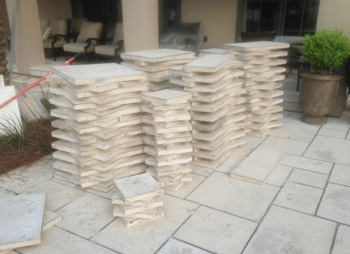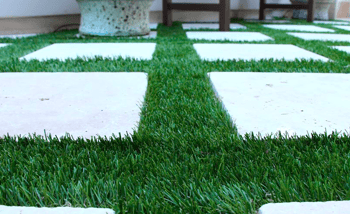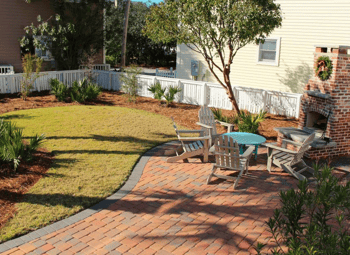 How hard is it to dig and rake out a flat area of the lawn and lay down pavers? Well, to do the job right, it’s surprisingly difficult. Some of our clients call us after trying it themselves, realizing that it’s harder than it looks to do it well.
How hard is it to dig and rake out a flat area of the lawn and lay down pavers? Well, to do the job right, it’s surprisingly difficult. Some of our clients call us after trying it themselves, realizing that it’s harder than it looks to do it well.
Creating a patio out of pavers is a great way to add usable space to your yard. You increase the flat surface area where you can put tables, lounge chairs and other outdoor furniture for entertaining — or relaxing.
But the question remains: Do you know how to lay patio pavers properly? Believe us, it's not easy.
Here's a closer look at problems homeowners commonly might come across when installing patio pavers.
4 Common Problems When Installing Patio Pavers
Using pavers, you can create an aesthetically pleasing pattern with attractive colors. Plus the pavers help control weeds, blocking out the space where they might grow. If you’re considering creating a patio or walkway and laying pavers at your North Florida Panhandle home, here are some issues to keep in mind before getting started.
The Base Is Just As Important As The Surface
The pavers can become uneven after laying them. The reason is that the base might not be compact or thick enough.
Solution: Before laying the pavers, use a mechanical compactor on the sand or gravel base. If using sand, moisten it after spreading, to help it become more even when compacting it. Many landscaping specialists prefer using processed gravel, which provides an even and sturdy base.
Whether using sand or gravel, you’ll need at least an inch thickness. If you discover that some of the pavers are uneven after you lay them, try using a vibratory plate compactor to go over the whole design. Then add more sand for the joints, repeating the process a few times until the pavers are even.
Settling Ground Means Sinking Pavers
 A section of the patio is sunken in a consistent way. What happened? The ground settled below that section. The base wasn’t prepared properly.
A section of the patio is sunken in a consistent way. What happened? The ground settled below that section. The base wasn’t prepared properly.
Solution: You’ll need to remove the pavers in the affected area to fill it in better before laying them again.
Pooling Water Could Be Poor Drainage
Water is pooling on certain sections of the patio after it rains. This is a drainage issue. The drainage pitch isn’t proper for the area.
Solution: To prevent water pooling while starting to prepare your patio for pavers, make sure there’s a quarter inch drop in elevation per foot of flat soil. And of course, make sure it drains away from your house! If you notice the problem after your patio is complete, you may be able to redo a section of the patio to accommodate the drainage issue, though pulling out a partial section can be problematic.
Pavers Become Loose After Use
The paver edges become loose. As you might imagine, the tightly packed pavers in the middle are sure to stay in place when pushed together with pressure. It’s harder for the edges, which don’t have that support.
Solution: Before installing the pavers, make sure to use an edging material to provide a strong support for the pavers on the border. A filter fabric can be placed under the base, extending to the edging material, to keep the sand or gravel base contained so it doesn’t leach out. Tightly compacting the pavers ensures that they have the best chance for success.
Popular Types Of Pavers For Patios in North Florida
 We’re lucky in this day and age to have so many options for patio pavers. The term pavers is a broad category of stones or bricks used for a patio type surface. Here are three popular types to consider for your North Florida home:
We’re lucky in this day and age to have so many options for patio pavers. The term pavers is a broad category of stones or bricks used for a patio type surface. Here are three popular types to consider for your North Florida home:
Interlocking Pavers
These attractive stone materials are easier to install because they’re evenly shaped and designed to fit together easily. They’re set with sand, so you don’t have to worry about concrete.
There’s a wide variety of colors, shapes, textures and designs you can make with them, and they’re readily available at many landscaping stores. They’re also durable and can withstand the Florida climate.
Natural Stone
These beautiful stone pavers are flat or mostly flat on top, with uneven borders. They’re popular because they provide a different look than the more regularly shaped interlocking pavers. They’re a little harder to set because the edges aren’t even, which often requires a concrete mortar in between them. The stones are durable and attractive, and look high end.
Brick
Many clients like the color and design options available with brick. The look is attractive and long lasting. Brick pavers are installed using sand, so you don’t need to worry about mixing and laying cement. Brick doesn’t come in as many color options as interlocking pavers, so that is a limiting issue for some clients.
Leave The Heavy Lifting To GreenEarth, Your Patio Paver Expert
If laying your own pavers sounds like more work than you want to do, or you want to make sure it gets done right the first time, give us a call. The experts here at GreenEarth can provide a plan and cost estimate for what you want to create in your patio area — as well as maintenance suggestions once the project is complete.
If you’d like a consultation or want to know what we can do to help you, give us a call at our Panama City Beach office at (850) 236-1959, or call our Santa Rosa Beach office at (850) 267-0010 to set up an appointment. You can also fill out the online form on our website to schedule a consultation.
We have the experience and equipment to build you a patio without the problems mentioned earlier, saving you time and frustration and giving you a patio you’ll enjoy for years to come.
.png?width=7889&height=5988&name=GE%20LOGO%20clear%20(1).png)
